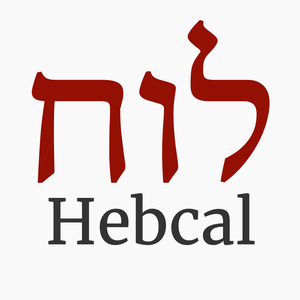Your comments
thanks for contacting Hebcal!
If you are able to create a translation of many names of holidays and sections of the Torah we would be delighted to offer Ukrainian. Do you have the time and expertise to help?
You would want to make a copy of an existing translation file, perhaps Russian, and use a tool like Poedit to create the Ukrainian translations
https://github.com/hebcal/hebcal-locales/blob/main/po/ru.po
Then, when you finish, you can post it as a file attachment here, as a GitHub pull request, or email the file to webmaster@hebcal.com
Thanks again and Shana tova!
Thanks for using Hebcal.
Thanks for the suggestion to add a calendar feed for Mishna Berura Yomi; we will consider this idea for the future.
Shana Tova!
Thanks for using Hebcal and thanks for posting your question here.
We don't currently have an option to display the day of the week on the Hebrew Date calendar feed. Thanks for the suggestion; we will consider this idea for the future.
Shana Tova!
Glad you got it working.
Yes, the major difference is parameters to control options. The Shabbat API attempts to keep things extremely simple (which means less flexibility). The Jewish calendar API is much more full-featured.
Hi, quick response: yes, indeed, this is by design. The Shabbat API always displays both Friday and Saturday, even if Friday has already passed.
No, there is no way to change this behavior.
If you want more control over date ranges use our Jewish calendar API and specify start and end parameters. The returned JSON is nearly identical to the Shabbat API so it should be easy to transition to this alternate API
Thanks for posting Evan!
We were curious so we did a bit more investigation on our end and actually we were able to reproduce your original problem on a Windows 11 PC using Excel 2021. Much to our huge surprise, a current version of Windows and a current version of Excel continue to have this issue. They are not handling UTF-8 (Unicode) CSV files correctly!
To help to remedy this situation, we have made a change to our CSV file export. We now include a Unicode Byte Order Mark at the beginning of the CSV file which helps Windows to detect that the CSV file contains Unicode data. This should improve CSV file imports for Hebrew and other languages the Hebcal.com website supports (Russian, Spanish, French, Polish, Hungarian, etc)
If you download a fresh CSV file from Hebcal.com today you may find that the Hebrew text now shows up correctly in Excel. (You may need to download it again in an Incognito/Private browser window to ensure that you aren't getting a cached version of the file.)
Hi, thanks for using Hebcal. We're sorry to hear that you're having difficulty getting a Google Calendar subscription feed to update after making changes on the Hebcal website.
Google Calendar is designed to refresh our calendars periodically. It usually takes 24 hours for changes to reflect, and in some cases may take up to 7 days for the calendar to update on the Google Calendar side.
I'll leave this question open for now and check back in a week to confirm that indeed the Google Calendar update has happened.
Thanks for writing back and thanks for providing that additional detail! I am glad to hear that The Events Calendar can correctly import Unicode CSV files even if Windows 7 cannot.
For what it's worth, we have tested the majority of the Hebcal.com website and download functionality on Windows 10 and Windows 11 so we are confident that it shows up correctly on those operating systems.
At this point Windows 7 is no longer supported by Microsoft, so perhaps the best long-term solution here is for you to upgrade your home PC to a newer version?
Thanks for using Hebcal. Sorry to hear you are having difficulty with Hebrew text in a CSV file export.
Perhaps you might be able to use another format, such as iCalendar? What program are you using to import the files into?
Also, what version of Windows on your PC?
Customer support service by UserEcho


Hi, thanks for your question.
This behavior is by design. The Shabbat API always displays the current week's information, including both Friday and Saturday, even if Friday has already passed. No, there is no way to change this behavior by specifying different start/end parameters.
If you want control over date ranges please instead use our Jewish calendar API and specify start and end parameters. The returned JSON is nearly identical to the Shabbat API so it should be easy to transition to this supported API.